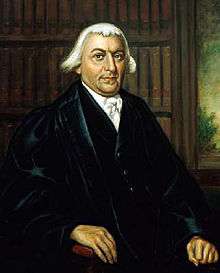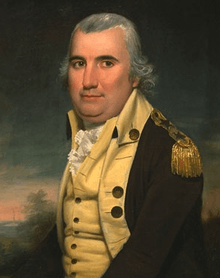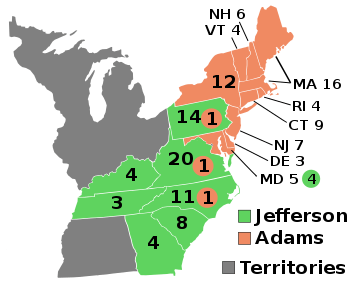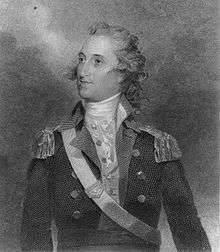United States presidential election, 1796
| | |||||||||||||||||||||||||||||||||||||||
| |||||||||||||||||||||||||||||||||||||||
| |||||||||||||||||||||||||||||||||||||||
|
| |||||||||||||||||||||||||||||||||||||||
| Presidential election results map. Presidential electoral votes by state. Because electors couldn't distinguish between their presidential and vice presidential choices until the passage of the Twelfth Amendment, the map above assumes that the presidential votes are exactly the votes for Adams or Jefferson. This leads to an anomaly: Maryland is listed as having cast 7 Federalist votes and 4 Democratic-Republican Party votes when Maryland had only 10 electors. One elector had run unopposed from his district, having pledged to vote for both Adams and Jefferson. Green denotes states won by Jefferson, burnt orange denotes states won by Adams. Numbers indicate the number of electoral votes allotted to each state. | |||||||||||||||||||||||||||||||||||||||
| |||||||||||||||||||||||||||||||||||||||
The United States presidential election of 1796 was the third quadrennial presidential election. It was held from Friday, November 4 to Wednesday, December 7, 1796. It was the first contested American presidential election and the only one in which a president and vice president were elected from opposing tickets.
With incumbent President George Washington having refused a third term in office, incumbent Vice President John Adams from Massachusetts became a candidate for the presidency on the Federalist Party ticket with former Governor Thomas Pinckney of South Carolina as the next most popular Federalist. Their opponents were former Secretary of State Thomas Jefferson from Virginia along with Senator Aaron Burr of New York of the Democratic-Republicans. At this point, each man from any party ran alone, as the formal position of "running mate" had not yet been established.
Unlike the 1792 election, where the outcome was a foregone conclusion, Democratic-Republicans campaigned heavily for Jefferson, and Federalists campaigned heavily for Adams. The campaign was an acrimonious one, with Federalists attempting to identify the Republicans with the violence of the French Revolution[1] and the Democratic-Republicans accusing the Federalists of favoring monarchism and aristocracy. Republicans sought to identify Adams with the policies developed by fellow Federalist Alexander Hamilton during the Washington administration, which they declaimed were too much in favor of Great Britain and a centralized national government. Paradoxically, Hamilton himself opposed Adams and worked to undermine his election. In foreign policy, Republicans denounced the Federalists over Jay's Treaty. Federalists attacked Jefferson's moral character, alleging he was an atheist, and a coward during the War of Independence. Adams supporters also accused Jefferson of being too pro-France; the accusation was underscored when the French ambassador embarrassed the Republicans by publicly backing Jefferson and attacking the Federalists right before the election.[2]
Federalist John Adams defeated Democratic-Republican Thomas Jefferson. Despite the vituperation between their respective camps, neither Adams nor Jefferson actively campaigned for the presidency.[3][4]
Jefferson received the second highest number of electoral votes and was elected vice president according to the prevailing rules of electoral college voting. This election marked the formation of the First Party System, and established a rivalry between Federalist New England and Democratic-Republican South, with the middle states holding the balance of power.[5]
Candidates
Prior to the ratification of the 12th Amendment in 1804, each elector was to vote for two persons, but was not able to indicate which vote was for president and which was for vice president. Instead, the recipient of the most electoral votes would become president and the runner-up vice president. As a result, both parties ran multiple candidates for president, in hopes of keeping one of their opponents from being the runner-up. These candidates were the equivalent of modern-day running mates, but under the law they were all candidates for president. Thus, both Adams and Jefferson were technically opposed by several members of their own parties. The plan was for one of the electors to cast a vote for the main party nominee (Adams or Jefferson) and a candidate besides the primary running mate, thus ensuring that the main nominee would have one more vote than his running mate.
Federalist candidates
The Federalists' nominee was John Adams of Massachusetts, the incumbent vice president and a leading voice during the Revolutionary period. Adams's main running mate was Thomas Pinckney, who due to electoral law at the time was technically running against Adams for president. This technicality became a reality when Alexander Hamilton, who felt some animosity towards Adams, began working behind the scenes to elect Pinckney over Adams by convincing Jefferson electors from South Carolina to cast their second votes for Pinckney. The scheme ultimately failed, but it set the stage for tension between Adams and Hamilton for the next four years.
-

James Iredell,
Associate Justice of the U.S. Supreme Court,
from North Carolina -

Charles Cotesworth Pinckney,
U.S. Minister to France
from South Carolina
Democratic-Republican candidates
-

Thomas Jefferson,
Former U.S. Secretary of State from Virginia -

George Clinton,
Former Governor of New York
Results

Tennessee was admitted into the United States after the 1792 election, increasing the Electoral College to 138 electors.
Under the system in place in 1796, electors were to cast votes for two persons. Both votes were for president; the runner-up in the presidential race was elected vice-president (this was prior to the passage of the Twelfth Amendment, which, in accommodating the notion of running mate, required that electors cast separate ballots for president and vice president). Each party intended to manipulate the results by having some of their electors cast one vote for the intended presidential candidate and one vote for somebody besides the intended vice-presidential candidate, leaving their vice-presidential candidate a few votes shy of their presidential candidate. Unfortunately, these schemes were complicated by several factors:
- All electoral votes were cast on the same day, and communications between states were extremely slow at that time, making it very difficult to coordinate which electors were to manipulate their vote for vice-president.
- There were rumors that southern electors pledged to Jefferson were coerced by Alexander Hamilton to give their second vote to Pinckney in hope of electing him president instead of Adams. Indeed, as it turned out, all eight electors in Pinckney's home state of South Carolina, as well as at least one elector in Pennsylvania, cast ballots for both Jefferson and Pinckney. Despite these extra votes, they were overwhelmed by at least 20 Adams electors who failed to cast their other vote for Pinckney.
The result was that Adams was elected president while his opponent, Jefferson, was elected vice-president.
| Presidential candidate | Party | Home state | Popular vote(a), (b), (c) | Electoral vote | |
|---|---|---|---|---|---|
| Count | Percentage | ||||
| John Adams | Federalist | Massachusetts | 35,726 | 53.4% | 71 |
| Thomas Jefferson | Democratic-Republican | Virginia | 31,115 | 46.6% | 68 |
| Thomas Pinckney | Federalist | South Carolina | — | — | 59 |
| Aaron Burr | Democratic-Republican | New York | — | — | 30 |
| Samuel Adams | Democratic-Republican | Massachusetts | — | — | 15 |
| Oliver Ellsworth | Federalist | Connecticut | — | — | 11 |
| George Clinton | Democratic-Republican | New York | — | — | 7 |
| John Jay | Federalist | New York | — | — | 5 |
| James Iredell | Federalist | North Carolina | — | — | 3 |
| George Washington | None | Virginia | — | — | 2 |
| John Henry | Democratic-Republican | Maryland | — | — | 2 |
| Samuel Johnston | Federalist | North Carolina | — | — | 2 |
| Charles Cotesworth Pinckney | Federalist | South Carolina | — | — | 1 |
| Total | 66,841 | 100.0% | 276 | ||
| Needed to win | 70 | ||||
Source (Popular Vote): U.S. President National Vote. Our Campaigns. (February 11, 2006).
Source (Popular Vote): A New Nation Votes: American Election Returns 1787-1825[6]
Source (Electoral Vote): "Electoral College Box Scores 1789–1996". National Archives and Records Administration. Retrieved July 30, 2005.
(a) Votes for Federalist electors have been assigned to John Adams and votes for Democratic-Republican electors have been assigned to Thomas Jefferson.
(b) Only 9 of the 16 states used any form of popular vote.
(c) Those states that did choose electors by popular vote had widely varying restrictions on suffrage via property requirements.
Consequences
The following four years would be the only time that the president and vice-president were from different parties (John Quincy Adams and John C. Calhoun would later be elected president and vice-president as political opponents, but they were both Democratic-Republican party candidates; Andrew Johnson, Abraham Lincoln's second vice-president, was a Democrat, but Lincoln ran on a combined Union Party ticket in 1864, not as a strict Republican). Jefferson would leverage his position as vice-president to attack President Adams's policies, and this would help him reach the White House in the following election.
This election would provide part of the impetus for the Twelfth Amendment to the United States Constitution. On January 6, 1797, Representative William L. Smith of South Carolina presented a resolution on the floor of the House of Representatives for an amendment to the Constitution by which the presidential electors would designate which candidate would be president and which would be vice-president.[7] However, no action was taken on his proposal, setting the stage for the deadlocked election of 1800.
Electoral college selection
The Constitution, in Article II, Section 1, provided that the state legislatures should decide the manner in which their Electors were chosen. Different state legislatures chose different methods:[8]
| Method of choosing electors | State(s) |
|---|---|
| Each Elector appointed by the state legislature | Connecticut Delaware New Jersey New York Rhode Island South Carolina Vermont |
| State is divided into electoral districts, with one Elector chosen per district by the voters of that district | Kentucky Maryland North Carolina Virginia |
| Each Elector chosen by voters statewide | Georgia Pennsylvania |
|
Massachusetts |
| Each Elector chosen by voters statewide; however, if no candidate wins majority, the state legislature appoints Elector from top two candidates | New Hampshire |
|
Tennessee |
See also
- Inauguration of John Adams
- History of the United States (1789-1849)
- First Party System
- United States House of Representatives elections, 1796
- United States Senate elections, 1796 and 1797
References
- ↑ Presidential Election of 1796, retrieved on November 5, 2009.
- ↑ "John Adams: Campaigns and Elections—Miller Center". millercenter.org. Retrieved April 15, 2016.
- ↑ "Inside America's first dirty presidential campaign, 1796 style". Constitution Daily. Retrieved April 15, 2016.
- ↑ "John Adams: Campaigns and Elections—Miller Center". millercenter.org. Retrieved April 15, 2016.
- ↑ Jeffrey L. Pasley, The First Presidential Contest: 1796 and the Founding of American Democracy (2013)
- ↑ http://elections.lib.tufts.edu/catalog?commit=Limit&f%5Belection_type_sim%5D%5B%5D=General&f%5Boffice_id_ssim%5D%5B%5D=ON056&page=2&q=1820&range%5Bdate_sim%5D%5Bbegin%5D=1820&range%5Bdate_sim%5D%5Bend%5D=1820&search_field=all_fields&utf8=%E2%9C%93
- ↑ United States Congress (1797). Annals of Congress. 4th Congress, 2nd Session. p. 1824. Retrieved June 26, 2006.
- ↑ "The Electoral Count for the Presidential Election of 1789". The Papers of George Washington. Retrieved May 4, 2005.
- Web references
- "A Historical Analysis of the Electoral College". The Green Papers. Retrieved March 20, 2005.
- A New Nation Votes: American Election Returns 1787-1825
Primary sources
- Cunningham, Noble E., Jr. ed. The Making of the American Party System 1789 to 1809 (1965), short excerpts from primary sources
- Cunningham, Noble E., Jr., ed. Circular Letters of Congressmen to Their Constituents 1789-1829 (1978), 3 vol; political reports sent by Congressmen to local newspapers
Further reading
- Encyclopedia of the New American Nation, 1754–1829 ed. by Paul Finkelman (2005), 1600 pp.
- The North Carolina Electoral Vote: The People and the Process Behind the Vote. Raleigh, North Carolina: North Carolina Secretary of State. 1988.
- Banning, Lance. The Jeffersonian Persuasion: Evolution of a Party Ideology (1978)
- Chambers, William Nisbet, ed. The First Party System (1972)
- Chambers, William Nisbet. Political Parties in a New Nation: The American Experience, 1776–1809 (1963)
- Charles, Joseph. The Origins of the American Party System (1956), reprints articles in William and Mary Quarterly
- Cunningham, Noble E., Jr. Jeffersonian Republicans: The Formation of Party Organization: 1789–1801 (1957)
- Cunningham, Noble E., Jr., "John Beckley: An Early American Party Manager," William and Mary Quarterly, 13 (Jan. 1956), 40-52, in JSTOR
- Dawson, Matthew Q. Partisanship and the Birth of America's Second Party, 1796-1800: Stop the Wheels of Government. Greenwood, (2000) online version
- DeConde, Alexander. "Washington's Farewell, the French Alliance, and the Election of 1796," Mississippi Valley Historical Review, Vol. 43, No. 4 (Mar. 1957), pp. 641–658 in JSTOR
- Dinkin, Robert J. Campaigning in America: A History of Election Practices. (Greenwood 1989) online version
- Elkins, Stanley and Eric McKitrick. The Age of Federalism (1995) online version, the standard highly detailed political history of 1790s
- Freeman, Joanne. "The Presidential Election of 1796," in Richard Alan Ryerson, ed. John Adams and the Founding of the Republic (2001).
- Miller, John C. The Federalist Era: 1789-1801 (1960).
- Pasley, Jeffrey L. The First Presidential Contes: 1796 and the Founding of American Democracy. Lawrence, KS: University Press of Kansas, 2013.
- Schlesinger, Arthur Meier, ed. History of American Presidential Elections, 1789–1984 (Vol 1) (1986), essay and primary sources on 1796
- Wood, Gordon S. Empire of Liberty: A History of the Early Republic, 1789–1815 (2009)
External links
- Presidential Election of 1796: A Resource Guide from the Library of Congress
- Election of 1796 in Counting the Votes
.jpg)

%2C_2nd_president_of_the_United_States%2C_by_Asher_B._Durand_(1767-1845)-crop.jpg)


.jpg)

